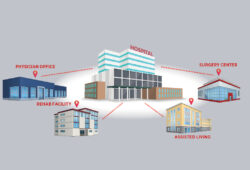Highlights from HealthTrust’s 2019 Robotics Summit
The market for orthopedic and spine surgery robotic systems is rapidly growing, with constant technological advancements. Last November, 42 representatives from HealthTrust member organizations gathered for a Robotics Summit, collaborating to sort through the many complexities associated with building a robotics program and creating action plans for their health systems. Here’s a snapshot of some of the components involved in making a robotics program a reality.
Consider the investment
First, health systems must analyze whether the investment in this new technology is going to provide worthwhile benefits. It can be difficult to tease out the value analysis of owning a robotics navigation system.

“No matter their size, every hospital or center must weigh whether the investment in this new technology will pay off in terms of quality of care, surgeon satisfaction and program growth,” says Karen Bush, MSN, FNP, BC, NCRP, Director of Clinical Research & Education at HealthTrust. “If the answer is ‘yes,’ then they must decide which robotic system will best fit their collective needs.”

Kade Huntsman, M.D., an orthopedic spine surgeon at the Salt Lake Orthopedic Clinic and the Chief of Surgery at St. Mark’s Hospital in Salt Lake City, Utah, sees the investment as worth considering. An early adopter of robotics (and all things technology), Dr. Huntsman delivered a keynote address on the current state of robotic surgery and served on the physician panel at the Summit. He expresses frustration about the fact that despite how technology has advanced so many facets of our lives, the OR has largely remained old-school and low-tech.
“Today, robots can fly airplanes, vacuum your house and drive your Tesla in traffic,” Dr. Huntsman says. “If we can do all these things, then we should be able to bring that higher technology into the operating room, where the stakes are the highest. It helps us become more efficient and accurate, and make smaller incisions to help patients recover faster.”

Brent Ford, former Clinical Director of inSight Advisory – Medical Device Management at HealthTrust, agrees that robotics has tangible benefits for patients and surgeons: “Robotics is exciting because the technology is moving toward improved precision in implant and screw placement, as well as better visualization and preoperative planning.”
Construct your team
A successful robotics program requires a team. Find a surgeon champion who is willing to put forth his or her passion, time and energy to develop the program. Enlist other surgeons, the CEO, CFO and the marketing team, who will get the word out.
When choosing a robotic product, Dr. Huntsman says that having a leader is imperative. “The process is going to be surgeon-driven, so you’ve got to have a surgeon champion who is willing to go through the learning curve.”
Evaluate the supplier
There are many factors to consider when choosing a supplier, which can feel overwhelming. It’s important to lay the groundwork internally first to establish a robust method for evaluating the value of new technology. “Involving physicians from the beginning is a must,” says Bush. Even if physicians know which robotic system they prefer, hospitals should still treat supplier selection as an RFP and bid it out. Before committing, be sure to address maintenance, warranties, upgrades versus updates, the cost of the robotic system and disposables (which can be a major cost), and methods for training.
Establish training guidelines
It’s important to attend supplier training. Robotic systems are all different, and each has its own specific set of workflows. Peer-to-peer mentoring can take training to another level. For example, a surgeon who has done 400 surgeries with the robot can help others learn from those experiences.
Some suppliers only make closed systems, meaning you must purchase and use only their screws, increasing the learning curve. There is a concerted effort to change this, so surgeons can work with the screws they’re comfortable using.
Win over late adopters
To convince surgical teams of the value in utilizing robotics systems, emphasize results. With the emergence of robotics, surgeons are now able to perform complicated surgical procedures with minor incisions, and patients can go home the next day versus being in the hospital for a week. With robotics-driven procedures, patients can experience less acute pain, less chronic pain and significantly less tissue damage.
“The goal is that these innovations translate into better quality and safer surgeries for patients and higher job satisfaction for surgeons,” says Ford.
Dr. Huntsman is excited at the thought of advancements moving forward. “I remember my dad’s cell phone that was the size of a shoebox, and we’ve all seen how phones have evolved. In the OR, we’re just now starting to see an evolution. Manufacturers are pushing the envelope and developing this technology quickly, and that’s fun.”
The HealthTrust Custom Contracting team utilizes best-in-class analytics and industry experience to maximize medical device savings in the orthopedic space.
For more information on how to maximize savings on orthopedic devices, contact Will Scott or Jimmy Yancey, members of the Medical Device Management Custom Contracting team.
Share Email Medical Devices, Q2 2020, Robotics, Surgery





